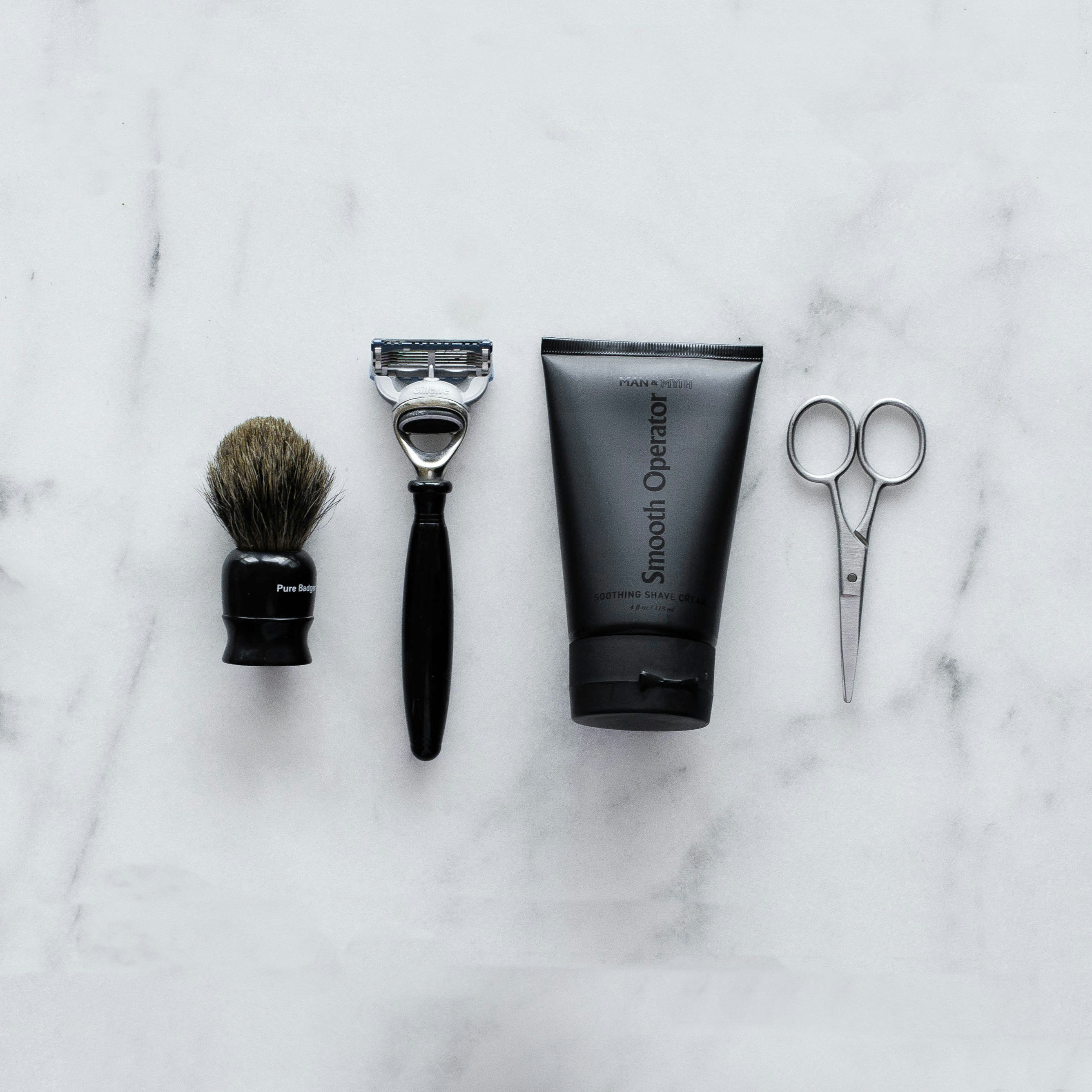Men's Grooming Essentials: The Complete Guide to Modern Masculine Care
Malik Mohsin Saleem Khan
June 12, 2023 · 14 min read

Introduction
In today's image-conscious world, men's grooming has evolved from a basic routine to an essential aspect of modern masculinity. Gone are the days when a simple shave and shower sufficed; contemporary men are embracing comprehensive grooming practices that enhance their appearance, boost confidence, and promote overall well-being. This guide to men's grooming essentials provides a roadmap for navigating the expanding landscape of male beauty and self-care.
From skincare fundamentals to hair maintenance, fragrance selection to beard cultivation, we'll explore the core elements that constitute a complete grooming regimen for the modern man. Whether you're a grooming novice looking to establish a basic routine or seeking to refine your existing practices, this comprehensive guide offers practical insights tailored to help you look and feel your best while expressing your personal style.
The Evolution of Men's Grooming
Men's relationship with grooming has undergone a remarkable transformation throughout history. Ancient civilizations like Egypt, Rome, and Greece placed high value on male grooming, with elaborate bathing rituals and cosmetic practices. However, the 20th century saw a significant simplification of men's routines, with masculinity often defined by a deliberate lack of attention to appearance beyond basic hygiene.
The past two decades have witnessed a renaissance in men's grooming. According to market research firm Euromonitor International, the global men's grooming industry has expanded to over $60 billion annually, growing at approximately 5.2% per year. This surge reflects changing attitudes toward masculinity and self-care, with younger generations particularly embracing more comprehensive grooming practices.
Today's grooming landscape is characterized by specialized products formulated specifically for men's unique physiological needs. Men's skin, typically thicker with higher collagen density and more active sebaceous glands than women's, benefits from targeted solutions. The modern grooming market has responded with expanded offerings across skincare, haircare, and body care categories, acknowledging that effective grooming goes far beyond the traditional shaving cream and aftershave.
Skincare Fundamentals: Building a Daily Routine
A solid skincare routine forms the foundation of effective men's grooming. Despite having naturally thicker skin with more collagen, men face unique challenges including frequent shaving irritation, increased oil production, and often, reluctance to adopt preventative care. A properly structured skincare regimen addresses these concerns while requiring minimal time investment.
The essential components of men's skincare include cleansing, exfoliating, moisturizing, and protecting. According to dermatologist Dr. Harold Lancer in an interview with GQ Magazine, "Men should cleanse twice daily with a pH-balanced face wash that removes impurities without stripping natural oils." This simple step removes accumulated dirt, excess sebum, and environmental pollutants that can lead to breakouts and dullness.
- Cleansing: Use a gentle, sulfate-free cleanser morning and night to remove dirt, oil, and impurities without stripping the skin
- Exfoliation: Incorporate chemical exfoliants containing AHAs or BHAs 2-3 times weekly to remove dead skin cells and prevent ingrown hairs
- Moisturizing: Apply a non-comedogenic moisturizer daily to maintain hydration and strengthen the skin barrier
Sun protection represents the most overlooked yet critical element in men's skincare. A 2019 study published in the Journal of the American Academy of Dermatology found that only 14.3% of men regularly use sunscreen on their face, despite higher rates of skin cancer among males. Incorporating a broad-spectrum SPF 30+ product daily protects against premature aging and reduces cancer risk significantly.
Hair and Beard Care: Maintenance and Styling
Proper hair and beard care elevates a man's appearance substantially, yet many men struggle with finding the right approach for their specific needs. Hair care should be tailored to your particular hair type and concerns, whether that's thinning, dryness, or styling challenges.
For scalp health, which directly impacts hair quality, dermatologists recommend washing hair 2-3 times weekly with sulfate-free shampoos that clean without stripping natural oils. According to a 2018 survey by the American Academy of Dermatology, 42% of men report concerns about hair thinning or loss, making it essential to incorporate scalp-stimulating ingredients like caffeine, saw palmetto, or ketoconazole in hair care products.
"The health of your hair begins with the health of your scalp. Think of your scalp as the soil in which your hair grows—it needs proper care and nourishment." — Thom Priano, celebrity men's hairstylist
Beard care has evolved into its own specialized category, with dedicated products addressing the unique challenges of facial hair maintenance. A proper beard regimen includes regular washing with specialized beard cleansers, conditioning to soften coarse hairs, and applying beard oils containing jojoba, argan, or grapeseed oils to moisturize both the hair and the skin underneath. For those experiencing beard dandruff (beardruff), products containing zinc pyrithione or tea tree oil can effectively combat flaking and itching.
Styling products should be selected based on hair type, desired finish, and hold requirements. Pomades offer high shine and moderate hold, while clay products provide a matte finish with stronger hold. For thinning hair, volumizing products with lightweight formulations prevent further weighing down of the hair while creating the appearance of fullness.
Fragrance and Body Care: The Finishing Touches
Fragrance represents one of the most personal aspects of a grooming routine, creating a lasting impression and often becoming a signature element of one's personal brand. The fragrance market for men has expanded dramatically, moving beyond traditional woody and spicy scents to include complex compositions with notes ranging from citrus and aquatic to gourmand and floral accords.
When selecting a fragrance, understanding the composition of top notes (the initial impression), middle notes (the heart of the fragrance), and base notes (the lasting impression) helps in making informed choices. Fragrance concentration also matters significantly—eau de parfum offers greater longevity than eau de toilette or cologne, requiring fewer applications throughout the day.
Body care extends beyond basic showering to include targeted treatments for specific concerns. Specialized body washes formulated with ingredients like salicylic acid can address issues like back acne, while regular exfoliation with body scrubs prevents ingrown hairs and improves skin texture. For athletes or men with active lifestyles, antimicrobial body products containing tea tree oil or silver nanoparticles help combat odor-causing bacteria more effectively than standard soaps.
Hand and nail care, often overlooked in men's grooming discussions, deserves attention as hands frequently reveal age and self-care habits. A simple routine of regular moisturizing with hand creams containing shea butter or glycerin, keeping nails trimmed and clean, and addressing cuticles can dramatically improve appearance and prevent common issues like hangnails and cracking.
Building Your Personal Grooming Routine
Creating an effective grooming routine requires balancing thoroughness with practicality. The goal is to develop sustainable habits that deliver results without becoming burdensome. Follow these steps to establish a personalized grooming regimen that works for your lifestyle and needs.
- Assess your specific concerns: Begin by identifying your primary grooming challenges—whether that's dry skin, razor bumps, thinning hair, or uneven beard growth. This assessment helps prioritize products and techniques that address your particular needs rather than adopting a generic approach.
- Start with the essentials: Build your routine around non-negotiable basics: cleansing, moisturizing, sun protection, regular haircuts, and proper body hygiene. Master these fundamentals before adding specialized treatments or products.
- Introduce products gradually: Rather than overhauling your entire routine at once, incorporate new products one at a time, using each for at least two weeks before adding another. This approach allows you to identify which products truly make a difference and which might cause adverse reactions.
- Create morning and evening protocols: Develop consistent morning and evening routines that can be completed in 10 minutes or less. Morning routines should focus on protection (moisturizer, SPF) and preparation for the day, while evening routines emphasize repair and recovery (deeper cleansing, treatment products).
- Schedule regular maintenance: Set reminders for recurring grooming needs like haircuts (typically every 3-4 weeks), beard trims, exfoliation sessions, and replacing products that expire.
Consistency is the key to seeing results from any grooming routine. Even the most expensive products yield limited benefits if used sporadically. Establish your core routine as a non-negotiable part of your daily habits, similar to brushing your teeth. For busy mornings, consider a minimalist approach focusing only on the absolute essentials, saving more involved treatments for evenings or weekends when you have more time.
The Future of Men's Grooming
The men's grooming industry continues to evolve rapidly, with several emerging trends poised to reshape how men approach self-care in the coming years. Personalization stands at the forefront of innovation, with brands developing diagnostic tools that analyze skin type, concerns, and environmental factors to create customized product recommendations or even bespoke formulations.
Sustainability is becoming increasingly central to men's grooming, with consumers showing preference for brands that prioritize environmentally responsible practices. This includes plastic-free packaging, waterless product formulations that reduce environmental impact, and transparent sourcing of ingredients. According to a 2022 report by market research firm Mintel, 64% of male consumers now consider environmental impact when purchasing grooming products—a figure that rises to 76% among millennials.
Technology integration represents another significant frontier, with smart devices like app-connected electric razors that analyze facial hair patterns and adjust cutting techniques accordingly. Virtual try-on tools using augmented reality allow men to visualize different hairstyles or beard shapes before making changes, reducing the uncertainty that often prevents experimentation with personal style.
Conclusion
The landscape of men's grooming has transformed dramatically, evolving from basic hygiene to a comprehensive approach to self-care that encompasses skincare, haircare, fragrance, and specialized treatments. This evolution reflects broader changes in how masculinity is defined, with personal care increasingly recognized as an essential aspect of well-being rather than a concession to vanity.
The most effective approach to grooming balances attention to detail with practicality, focusing on consistent application of proven essentials rather than constantly chasing trends. By understanding your specific needs, establishing sustainable routines, and making informed product choices, you can develop a grooming regimen that enhances your natural attributes while addressing your unique concerns.
Remember that grooming is ultimately about self-respect and personal confidence rather than meeting external standards. The time and attention you invest in your appearance reflects the value you place on presenting your best self to the world—an investment that pays dividends in both personal and professional contexts.
Frequently Asked Questions
How much time should I spend on my daily grooming routine?
An effective daily grooming routine can be completed in 10-15 minutes. Focus on essential steps like cleansing, moisturizing, and sun protection in the morning, with perhaps a more thorough routine in the evening. The key is consistency rather than length—a brief but regular routine yields better results than occasional intensive sessions.
Are expensive grooming products worth the investment?
Higher price doesn't always correlate with better results. Focus on products with proven active ingredients rather than luxury packaging or marketing. That said, certain ingredients like stabilized vitamin C or retinol often cost more to formulate effectively. Research ingredients and start with moderately priced options before investing in premium products.
How do I know which products are right for my skin type?
Identify your skin type (oily, dry, combination, or sensitive) by observing how your skin behaves throughout the day. Oily skin benefits from gel-based products with ingredients like salicylic acid, while dry skin needs cream formulations with hyaluronic acid or ceramides. When in doubt, consult a dermatologist for personalized recommendations based on your specific concerns.
Is it necessary to use products specifically formulated for men?
While men's skin tends to be thicker with more active oil glands, the key ingredients that benefit skin are largely the same regardless of gender. Men-specific products often feature formulations that address common male concerns like razor irritation or oiliness, but the most important factor is finding products with effective ingredients that work for your specific skin type and concerns.
Malik Mohsin Saleem Khan
Founder
Author bio information


